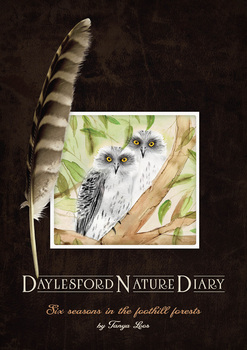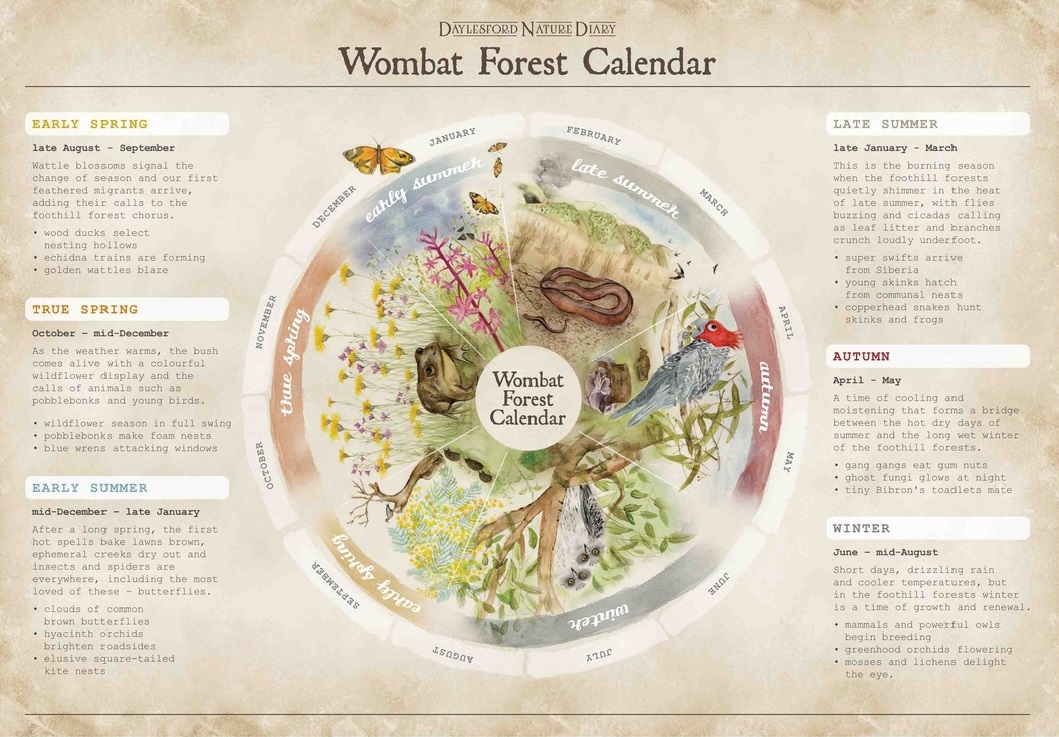Book: Daylesford Nature Diary
In 2013, I published a book! This beautiful little publication has sold over 1000 copies. To purchase – click the Add to Cart button under the picture of the cover on the right.
Below is a 2013 interview from the Local, by Donna Kelly, where I talk about the Daylesford Nature Diary…
Why did you decide to write the Daylesford Nature Diary?
I have been writing a monthly nature column in the Advocate since 2009, and this has been one of the most enjoyable things I have ever done. I simply love noticing a certain type of plant in flower, or some interesting animal behaviour whilst out and about and then crafting it into a short story to share. The feedback over the years has been wonderful; as people stop me in the supermarket or at the servo to talk about “their” wrens or pobblebonks. I had also heard of people cutting out and saving the articles for friends or family, or people in Melbourne who visit the area.
So I thought – why not put these stories into a lovely book? And my friendships with Gib Wettenhall ( editor of EmPress Publishing) and Mel Woolcock ( amazing graphic designer) meant that I had a team ready to create a quality publication. I was also thrilled the Gib involved Anne Mason in the project, who did the beautiful watercolour illustrations.
And instead of just printing the articles as they appeared in the paper, I wanted to add a little something extra for my long-time readers. I created a six season calendar for the Wombat Forest, and ordered the stories in the book according to the seasons. The concept of six seasons instead of the four European seasons is based on indigenous calendars, which follow the weather patterns and the behaviour of flora and fauna to mark the seasons, rather than dates! So the subtitle of the book is ‘six seasons in the foothill forests’.


What will it offer local people?
People in this area really enjoy the forest, and the plants and animals that we share our lives with. The stories aim to deepen this appreciation by providing a focus on a particular plant or animal, and what is happening in their world at any given point in the year. So we might be observing a mass flowering of egg and bacon plants, or clouds of Common Brown Butterflies, or hearing koalas call at night.
The articles also offer tips on the practicalities of living with wildlife – birds attacking windows, turtles on the roads and big old male kangaroos camping in the backyard!
The book is a great primer for those moving to the area to live, and who are keen to get to know their local nature but unsure where to start. I have also heard of people from overseas taking it as a memento of the Australian wildlife and forest they enjoyed on their visit.
The Daylesford Nature Diary is great for families too! This year, myself and nature educator Jen Bray have been leading Family Nature Walks – guided walks into our local environment according to the six seasons. In Autumn over fifty kids and adults explored the fungi and Blackwood, and in Winter we were delighted to observe a healthy Wombat whilst doing fern spotting at Nolan’s Creek deep in the Wombat Forest. Our next walk is focused on birds and their babies at Jubilee Lake.
Why is it important to be aware of our surroundings and nature itself?
There is something so special about noticing plants flowering, or frog nests in the dam – the best way I can describe it is like this: you move to a new area and you don’t know anyone. But then a couple of years later, you have built up a picture of where your friends and colleagues live, where you have enjoyed a lovely swim or art event, and the landscape becomes special and familiar and populated with people and places you love and memories you cherish. I feel that way about the Wombat Forest as I get to know certain trees, particular nesting hollows or the seasonal visits of particular birds. And I am hoping the book and the ongoing articles in the Advocate help people feel that way too!
The other thing about awareness is that it engenders respect – if you educate yourself about the orchids growing on your block, or the ringtail possums in your garden or the bats in your roof, you are better able to make decisions that take the wellbeing of these living things into account. How we drive, care for our pets, build our dwellings, and the food we choose to eat all have profound effects on the welfare of nature and animals. I am very much a local person, but the principles of awareness, education and then taking respectful action could most certainly be applied on a global scale at the moment.
What, to you, is so beautiful about our world?
What a wonderful question! I adore the sunlight streaming through the clouds like the god or goddess touching the earth, the moon in all her phases and sizes and positions in the sky, and the formation of rocks and larger landforms. And then these forms are clothed in plant life of such variety – communities of flowers, grasses, shrubs and trees all creating this layered web of beauty. And then the exquisite forms of sentient life within these communities!
I truly believe that all animals from the unicellular size to humans share the same consciousness and lust for life. As a field naturalist who spend a lot of time quietly watching nature, I have watched animals hunting, fighting, making homes, resting, finding food – and moments of profound emotion, such as tenderness between mates, playfulness, grief and contentment. If you think of these lives being played out in day and night and seasonal cycles all over this tiny blue and green planet – well, there is nothing more beautiful!
Friends of Box Ironbark Forests review the book here
To read about the book or buy from Empress Publishing click here
Daylesford Nature Diary is available for purchase at Paradise Books, Daylesford Information Centre and through me directly via the Add To Cart button near the top right